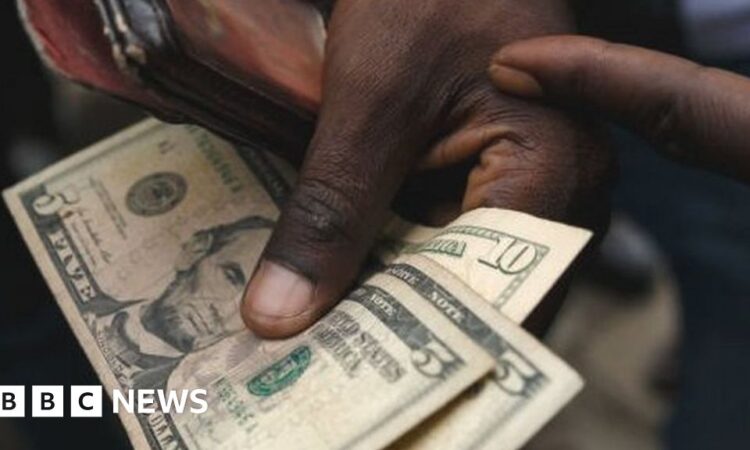
Zimbabwe’s government has taken the controversial decision to ban local trading in foreign currencies, including the US dollar, with immediate effect.
It has also reintroduced the Zimbabwe dollar, which was abandoned because of hyperinflation in 2009 when the country mainly adopted the US dollar and the South African rand.
The move has shocked Zimbabweans, who have little faith in a local currency – the exchange rate when the Zimbabwe dollar was scrapped was Z$35 quadrillion to $1.
What has prompted the move?
The economy is a mess. Nearly everything is imported and there is a shortage of physical cash. The cost of living is very expensive. Unemployment is widespread.
Various things have been tried to solve the problem, including the introduction in 2016 of bond notes, a parallel currency that was only accepted in Zimbabwe.
It was officially pegged to the US dollar but in reality was worth much less – so a thriving black market developed and Zimbabwe has become a cashless society, relying on card-based transactions or trading with mobile money.
You may also be interested in:
In February, bond notes and electronic cash were re-branded RTGS dollars and allowed to float to try and crush the black market.
However, workers, who used to get their salaries paid in US dollars, have found that their salaries in RTGS dollars are not able to keep up with inflation – now running at 100%.
People were often expected to pay for goods in shops and services, like doctors’ fees, in US dollars.
President Emmerson Mnangagwa said the ban was an “important step in restoring normalcy to our economy”.
“While the multi-currency regime helped stabilise the economy, it did not give us control of monetary policy and left us at the mercy of US dollar pricing which has been a root cause of inflation,” he added.
The authorities also say because the US dollar is so strong, producing goods locally is expensive which is why businesses prefer to import goods.
What has been the reaction?
Most people, who associate the Zimbabwe dollar with food shortages and runaway inflation, have complained about the lack of warning. The RTGS officially became the Zimbabwe dollar on Monday, the only legal tender.
“We should have our own currency. But they shouldn’t have abolished it as if they were swatting a fly. They should have given us notice,” one man told the BBC.
Supermarkets and those in the formal sector responded a day after the announcement by issuing new prices in Zimbabwean dollars – but they were beyond the means of many.
A first-time doctor’s consultation is now Z$1,800 – more than a teacher or nurse earns in a month.
Informal traders, who dominate the economy and need US dollars for imports, have vowed to defy the directive.
A street vendor in the capital, Harare, told the BBC: “How is it possible that the US dollar is no longer accepted? It won’t work. We actually want greater use of it, so that as street vendors we can have them. Scrap the bond note instead.”
Opposition Movement for Democratic Change (MDC) lawmaker David Coltart called the move “sheer madness”.
“The market has been re-dollarising because of lack of confidence in the RTGS dollar. You can’t force people to love a currency… This will exacerbate the chaos,” he said on Twitter.
Will these objections make any difference?
The trade unions have threatened “mass action” if the policy is not reversed.
Image source, Getty Images
The Zimbabwe Congress of Trade Unions (ZCTU) wants workers to be paid in US dollars again.
In January, it led nationwide protests against a 150% fuel price increase, triggering a violent crackdown by the army and police that rights groups say left at least 12 people dead.
On the streets of the capital, black market traders are still exchanging and accepting US dollars.
The value on the black market has remained unchanged – one US dollar is worth 11 Zimbabwe dollars, compared with the official rate of 6.2.
Ultimately Zimbabweans have proved good at adapting over the years to one economic crisis after another.
Why do Zimbabweans prefer foreign currencies?
They are scarred by the mismanagement of the economy by the government of then-President Robert Mugabe. The central bank was forced to print banknotes of ever higher values to keep up with surging inflation.
Annual inflation reached 231 million per cent in July 2008. Officials gave up reporting monthly statistics when it peaked at just under 80 billion per cent in mid-November 2008.
The prices of goods multiplied several times a day. Though it was illegal at the time, many people opted to keep US dollars, which they bought on the black market.
Businesses began demanding foreign currency. Eventually authorities were forced to catch up, scrapping the Zimbabwe dollar and sanctioning the use of several currencies, including the Chinese yuan and Indian rupee.
But in reality Zimbabwe ran out of all these currencies because it was importing far more than exporting – and has become a cashless society.



